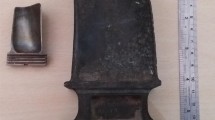This paper considers the influence of the mass flow of the gas ingested from the cavity formed by the rotor-to-stator clearance on the formation and structure of secondary flows in the blade passage of the gas-turbine stage. The flow is described by the Reynolds-averaged Navier-Stokes equations, to close which the Spalart-Allmaras model and the k-ε model of turbulence with corrections for the rotation and curvature of the streamlines are used. Comparison of the results of the numerical simulation obtained from the point of view of different turbulence models is made.
Similar content being viewed by others
References
M. C. Spencer and T. V. Jones, Endwall heat transfer measurements in an annular cascade of nozzle guide vanes at engine representative Reynolds and Mach numbers, Int. J. Heat Fluid Flow, 17, No. 2, 139–147 (1996).
N. Aunpapu, R. Volino, K. Flack, and R. Stoddard, Secondary flow measurements in a turbine passage with endwall flow modification, ASME Paper, No. GT-2000-0212 (2000).
Y. J. Moon and S. R. Koh, Counter-rotating streamwise vortex formation in the turbine cascade with endwall fence, Comput. and Fluids, 30, 473–490 (2001).
G. P. Virr, J. W. Chew, and J. Coupland, Application of computational fluid dynamics to turbine disc cavities, ASME J. Turbomachinery, 116, 701–708 (1994).
K. Jarzombek, H. J. Dohman, F. K. Benra, and O. Scheider, Flow analysis in gas turbine pre-swirl cooling air systems — variation of geometric parameters, ASME Paper, No. GT-2006-90445 (2006).
K. Reid, J. Denton, G. Pullan, E. Curtis, and J. Longley, The effect of stator-rotor hub sealing on the mainstream aerodynamics of a turbine, ASME Paper, No. GT-2006-90838 (2006).
S. Shahpar, D. Giacche, and L. Lapworth, Multi-objective design and optimization of bypass outlet guide vanes, ASME Paper, No. GT-2003-38700 (2003).
D. Kozulovic and T. Rober, Modelling of streamline curvature effects in turbomachinery flows, ASME Paper, No. GT-2006-90265 (2006).
R. Pecnik, P. Pieringer, and W. Sanz, Numerical investigation of the secondary flow of a transonic turbine stage using various turbulence closures, ASME Paper, No. GT-2005-68754 (2005).
C. Cao, J. W. Chew, P. R. Millington, and S. I. Hogg, Interaction of rim seal and annulus flows in an axial flow turbine, ASME J. Eng. Gas Turbines Power, 126, 786–793 (2003).
R. Jakoby, K. Lindblad, J. Larsson, L. de Vito, D. Bohn, J. Funcke, and A. Decker, Numerical simulation of the unsteady flow field in an axial gas turbine rim seal configuration, ASME Paper, No. GT-2004-53829 (2004).
J. Boudet, V. N. D. Autef, J. W. Chew, N. J. Hills, and O. Gentilhomme, Numerical simulation of rim seal flows in axial turbines, The Aeronaut. J., 109, 373–383 (2005).
J. Boudet, N. J. Hills, and J. W. Chew, Numerical simulation of the flow interaction between turbine main annulus and disc cavities, ASME Paper, No. GT-2006-90307 (2006).
B. Rosic, J. D. Denton, and G. Pullan, The importance of shroud leakage modelling in multistage turbine flow calculations, ASME Paper, No. GT-2005-68459 (2005).
D. Cherry, A. Wadia, R. Beacock, M. Subramanian, and P. Vitt, Analytical investigation of a low pressure turbine with and without flowpath endwall gaps, seals and clearance features, ASME Paper, No. GT-2005-68492 (2005).
R. P. Roy, J. Feng, Saurabh P. Narzary, and R. E. Paolillo, Experiments on gas ingestion through axial-flow turbine rim seals, ASME Paper, No. GT-2004-53394 (2004).
P. R. Spalart and S. R. Allmaras, A one equation turbulence model for aerodynamic flows, AIAA Paper, No. 92-0439 (1992).
J. Dacles-Mariani, G. G. Zilliac, J. S. Chow, and P. Bradshaw, Numerical/experimental study of a wingtip vortex in the near field, AIAA J., 33, No. 9, 1561–1568 (1995).
B. E. Launder and D. B. Spalding, The numerical computation of turbulent flows, Comput. Meth. in Appl. Mech. Eng., 3, 269–289 (1974).
M. Kato and B. E. Launder, The modelling of turbulent flow around stationary and vibrating square cylinders, in: Proc. 9th Symp. on Turbulent Shear Flows, 16–18 August 1993, Kyoto, Japan (1993), Vol. 9, pp. 10.4.1–10.4.6.
M. A. Leschziner and W. Rodi, Calculation of annular and twin parallel jets using various discretization schemes and turbulent-model variations, ASME J. Fluid Eng., 103, 353–360 (1981).
A. V. Ermishin and S. A. Isaev (Eds.), Control of the Flow Past Bodies with Vortical Cells as Applied to Flying Vehicles of Integrated Arrangement (Numerical and Physical Modeling) [in Russian], Moscow, St. Petersburg (2001).
K. N. Volkov, Application of the control-volume method to the solution of problems of fluid mechanics on unstructured grids, Vychisl. Metody Programmir., 6, No. 1, 43–60 (2005).
Author information
Authors and Affiliations
Corresponding author
Additional information
Translated from Inzhenerno-Fizicheskii Zhurnal, Vol. 81, No. 4, pp. 721–731, July–August, 2008.
Rights and permissions
About this article
Cite this article
Volkov, K.N. Influence of ingested gas crossflow on the formation and structure of secondary flows in the blade passage of a gas turbine. J Eng Phys Thermophy 81, 748–759 (2008). https://doi.org/10.1007/s10891-008-0096-2
Received:
Published:
Issue Date:
DOI: https://doi.org/10.1007/s10891-008-0096-2



